Introduction
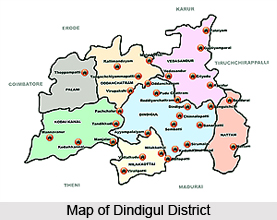 Dindigul District is one of the administrative districts of Tamil Nadu and is situated in the western part. It was carved out of Madurai District in 1985. It is well connected by road and rail and airways. Administration of Dindigul District comprises of three Revenue Divisions, eight taluks and 14 Panchayat Unions, According to 2001 Census, total population of Dindigul District is 19,23,014 with a literacy rate of 69.83 percent. Madurai Airport is located at a distance of 45 kms from Dindigul town.
Dindigul District is one of the administrative districts of Tamil Nadu and is situated in the western part. It was carved out of Madurai District in 1985. It is well connected by road and rail and airways. Administration of Dindigul District comprises of three Revenue Divisions, eight taluks and 14 Panchayat Unions, According to 2001 Census, total population of Dindigul District is 19,23,014 with a literacy rate of 69.83 percent. Madurai Airport is located at a distance of 45 kms from Dindigul town.
Location of Dindigul District
Dindigul District is located between 10 degree 5 minutes and 10 degree 9 minutes north latitude and 77 degree 30 minutes and 78 degree 20 minutes east longitude. Dindigul District is bounded by Erode District, Coimbatore District, Karur District and Trichy district on the north, by Shivaganga and Tiruchi District on the east, by Madurai district on the south and by Theni District and Coimbatore Districts and by the state of Kerala on the west. It is spread over on area of 6266.64 sq kms.
History of Dindigul District
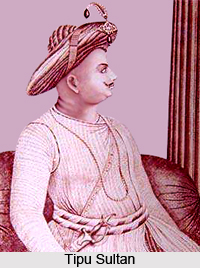 History of Dindigul district in Tamil Nadu reveals that it was formed on fifteenth of September 1985, when it was carved out of the composite Madurai District. The first District Collector was Thiru.M.Madhavan Nambiar, I.A.S. This district had the names of Dindigul Anna, Quaid-e-Milleth and Mannar Thirumalai. The people living in the district of Dindigul were known as Madurai Jilla Makal. Earlier, Dindigul was under the rule of the famous Muslim Monarch, Tipu Sultan. The historical Rock Fort of this district was constructed by the famous Naik King Muthukrishnappa Naicker. The Dindigul district is bound by Erode, Coimbatore, Karur and Trichy districts to the North, by Sivaganga and Tiruchi district to the East, Madurai district to the South and the Theni and Coimbatore districts and the state of Kerala to the West. This district stretches over an area of 6266.64 square kilometres. The district has three Revenue Divisions, eight Taluks and fourteen Panchayat Unions, and as per the 2001 Census, its population is 19, 23,014.
History of Dindigul district in Tamil Nadu reveals that it was formed on fifteenth of September 1985, when it was carved out of the composite Madurai District. The first District Collector was Thiru.M.Madhavan Nambiar, I.A.S. This district had the names of Dindigul Anna, Quaid-e-Milleth and Mannar Thirumalai. The people living in the district of Dindigul were known as Madurai Jilla Makal. Earlier, Dindigul was under the rule of the famous Muslim Monarch, Tipu Sultan. The historical Rock Fort of this district was constructed by the famous Naik King Muthukrishnappa Naicker. The Dindigul district is bound by Erode, Coimbatore, Karur and Trichy districts to the North, by Sivaganga and Tiruchi district to the East, Madurai district to the South and the Theni and Coimbatore districts and the state of Kerala to the West. This district stretches over an area of 6266.64 square kilometres. The district has three Revenue Divisions, eight Taluks and fourteen Panchayat Unions, and as per the 2001 Census, its population is 19, 23,014.
For long, Dindigul is associated with iron locks, iron safe of good quality and durability. There is a lock manufacturing unit under co-operative sector which functions in this district. Another industry for which the district Dindigul is well-known is leather tanning. The district is an important wholesale market for onion and groundnut. It has a network of inter-district roads connecting Madurai, Coimbatore, Tiruchi, Erode, Karur and Shivaganga District.
Dindigul district is well-developed educationally with several High and Higher Secondary Schools to its credit. The St.Mary`s Higher Secondary School, a well disciplined institution is one of the oldest institutions in this city. The district possesses two Universities, which are Mother Teresa Women`s University at Kodaikanal and Gandhigram Rural Deemed University at Gandhigram. There are also several Arts & Science Colleges, Engineering Colleges, Polytechnics, ITIs, etc are available in the district.
Geography of Dindigul District
Dindigul District receives an average rainfall of 700 mm and the average temperature is relatively high varying from 26 degree Celsius to 38 degree Celsius. The main rivers of the district are Kodaganaru, Palar, Kuthiraiyar, Porandalar, Amravati, Manjalar, Varadhamanathi and Maruthanathi.
Economy of Dindigul District
Dindigul District has a flourishing economy well known for its iron locks, tobacco and handloom industry. The main occupation of the people living in the district is agriculture and the district has more than 200,000 hectare of cultivable area. Rice, pulses, sugarcane, groundnut, gingelly, cotton and millets are the main crops that are grown here. For a long time, Dindigul town has been associated with Iron locks, Iron safe of good quality and durability. A lock manufacturing unit under co-operative sector is functioning here. Another industry for which Dindigul is popular is Leather Tanning. Dindigul District is having a flourishing handloom industry at Chinnalapatti.
Temples in Dindigul District
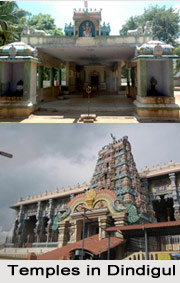 Temples in Dindigul district attract devotees from all corners of the country through out the year. This district is privileged to have one of the six famous hill abodes of Lord Muruga at Palani Hills, where the famous Dhandayuthapani temple is situated on the hilly rock at a height of about four hundred and fifty meters. Thousands of pilgrims visit this temple every day, especially during festival days, including Thaipoosam, Adi-kiruthigai, Panguni Uthiram, Sura-samharam, Vaikasi-visagam and monthly Karthigai. Apart from the renowned Murugan Temple, there is also another Murugan temple at Thirumalaikeni, which is situated at a distance of twenty five kilometers from Dindigul town.
Temples in Dindigul district attract devotees from all corners of the country through out the year. This district is privileged to have one of the six famous hill abodes of Lord Muruga at Palani Hills, where the famous Dhandayuthapani temple is situated on the hilly rock at a height of about four hundred and fifty meters. Thousands of pilgrims visit this temple every day, especially during festival days, including Thaipoosam, Adi-kiruthigai, Panguni Uthiram, Sura-samharam, Vaikasi-visagam and monthly Karthigai. Apart from the renowned Murugan Temple, there is also another Murugan temple at Thirumalaikeni, which is situated at a distance of twenty five kilometers from Dindigul town.
Abirami Amman temple in Dindigul district and Raja Kaliamman temple at Thethupatti are twenty kilometers from Dindigul, are some of the important temples which attract thousand of pilgrims to this district. Thadikombu is the Perumal temple which is five kilometers from Dindigul on the way to Karur district. During the month of Chitra, Lord Alagar gets twelve days of special Pooja. During full moon day of the month, Lord Alagar gets out on a procession of Ethir Servai.
The Sri Kottai Mariamman Kovil temple is more than two hundred years old. The Mariamman idol is said to be installed by the army men of Tipu Sultan at the fort of the mountain. Hence it is called Kottai Mariamman temple. The temple is built in the shape of a square. There is a temple for Vetri Vinayaka at the South and Lord Muruga at the north of this temple. There is a Mandapam or a hall in the centre of the ground in which there is a sculpture of a Lion facing the Sannidhi. The sanctum sanctorum is small and square shaped. The deity consecrated is seen here, embedded deeply under the floor. Several sculptures are there on the sniper structure over the sanctum sanctorum, depicting a number of the goddess Mariamman. All the four sides, various scenes showing the destroying of monster by the goddess are seen. On the eastern side over the Amman Sannidhi is a temple for Vinayaka and on western side a temple for Madurai Veeran. On the front side of Sannidhithe Navagraha idols are installed. On the back side of the temple, there is an idol of Goddess Kali and another one for Goddess Durga. The temple is located in such a large area as two acres. The golden shield adorns the deity on every day between 5 P.M. to 9 P.M. The temple is run by a board of Trustees.
The Abirami Amman temple is situated in the centre of the district. During Navaratri, Goddess Abirami is on Kolu. There are about one lakh archana offered to the Goddess Gnamambikal. During the Fridays of Adi month there is a procession of Goddess Abirami on a flower Pallak. Another major temple is the Anjaneyar Temple, which is situated in the Nadupatti Taluk. It is at a distance of about thirty five kilometers from Dindigul.
Tourism in Dindigul District
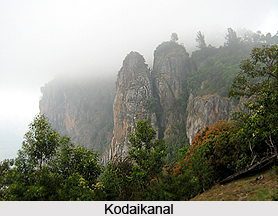 Tourism in Dindigul district in Tamil Nadu presents several beautiful historical monuments, temples, churches, mosques, etc. There are various tourist destinations, historical places of interest and many other interesting spots which attract people from various parts of the country to this district of the state of Tamil Nadu. One of the most prominent tourist places in this district is Kodaikanal. It is a well-known Summer Resort, which is situated at an altitude of two thousand one hundred and thirty three meters in the Western Ghats. A notable feature of this hillock is Kurunji flowers which bloom once in twelve years. The next blooming of this flower will be in the year 2018.
Tourism in Dindigul district in Tamil Nadu presents several beautiful historical monuments, temples, churches, mosques, etc. There are various tourist destinations, historical places of interest and many other interesting spots which attract people from various parts of the country to this district of the state of Tamil Nadu. One of the most prominent tourist places in this district is Kodaikanal. It is a well-known Summer Resort, which is situated at an altitude of two thousand one hundred and thirty three meters in the Western Ghats. A notable feature of this hillock is Kurunji flowers which bloom once in twelve years. The next blooming of this flower will be in the year 2018.
Sirumalai and Peranai are the two prominent picnic spots of this district in Tamil Nadu state. 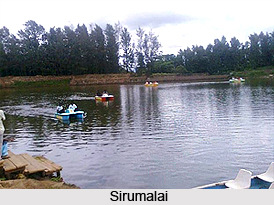 There are nine dams in this district which are Varathamanathi, Palar Porundalar, Kuthiraiaru in Palani Block, Parappalar and Nanganchiar in Oddanchatram Block, Maruthanathi, Kamarajar Sagar in Athoor Block, Mavoor in Nilakottai Block, Kudaganar in Vedasandur Block, which helps in irrigating the agricultural fields in this district. The Nilakkottai is known for brass vessels and jewellery. Nilakottai Taluk is well-known for the growing and marketing of flowers and grapes. Oddanchatram is a reputed market Centre for vegetables and Batlagundu is an important market Centre for Tomato. Pattiveeranpatti in Batlagundu block is renowned for cardamom and coffee curing enterprises.
There are nine dams in this district which are Varathamanathi, Palar Porundalar, Kuthiraiaru in Palani Block, Parappalar and Nanganchiar in Oddanchatram Block, Maruthanathi, Kamarajar Sagar in Athoor Block, Mavoor in Nilakottai Block, Kudaganar in Vedasandur Block, which helps in irrigating the agricultural fields in this district. The Nilakkottai is known for brass vessels and jewellery. Nilakottai Taluk is well-known for the growing and marketing of flowers and grapes. Oddanchatram is a reputed market Centre for vegetables and Batlagundu is an important market Centre for Tomato. Pattiveeranpatti in Batlagundu block is renowned for cardamom and coffee curing enterprises.
Dindigul Fort is one of the best tourist destinations in the district. The construction of this fort was started by Madurai King, Muthu Krishna Naicker in the year 1605 and from the year 1623 to 1659 Mannar Thirumalai Naicker completed the construction of this fort. From 1784 to 1790 the Fort was under the rule of `Tipu Sultan`. In the year 1784, the Tipu Sultan`s Commandant Syed Ibrahim, under whose care the Fort was, constructed many rooms in the Fort, strengthened the walls and also got repaired. During the year 1790 in the Mysore War, Tipu Sultan was defeated and the Fort came into the hands of British. This fort thus holds a prominent place in the history of pre-independent India and people visit this place to have a glimpse at the old fort once under the control of the great Tipu Sultan.
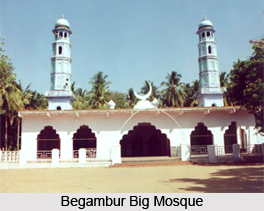 When Hyder Ali ruled Dindigul, he constructed three Mosques. One for himself for Namaz, another for his soldiers underneath Rock Fort and the third in the south of Rock Fort for public and gave more grants for the maintenance and upkeep of the same. In the 1766 AD, Ameer-un-Nisha Begum, the wife of Killedar Mir Riza Ali Khan and the younger sister of Hyder Ali Bahadur, was dead and buried in the compound of the Begambur Big Mosque. A Tomb was constructed on it. In memory of the Royal lady this part of Dindigul is known as Begambur.
When Hyder Ali ruled Dindigul, he constructed three Mosques. One for himself for Namaz, another for his soldiers underneath Rock Fort and the third in the south of Rock Fort for public and gave more grants for the maintenance and upkeep of the same. In the 1766 AD, Ameer-un-Nisha Begum, the wife of Killedar Mir Riza Ali Khan and the younger sister of Hyder Ali Bahadur, was dead and buried in the compound of the Begambur Big Mosque. A Tomb was constructed on it. In memory of the Royal lady this part of Dindigul is known as Begambur.
Sirumalai is a small hill station in the district which holds a number of birds and animals. The place is well-known for trekking and mountaineering. Apart from this, there is the St. Joseph Church, which is located in this district. The church was constructed since 1866 to 1872 by the British. This church is the Head Church of all other Roman Catholic Churches in Dindigul District.
Visiting Places of Dindigul
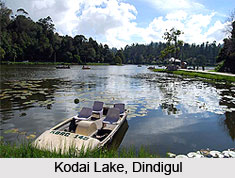 Dindigul is a beautiful place in Tamil Nadu. It is well connected by national highways to all the important towns of India. It is situated 430 kms from Chennai. Buses are available from Chennai, Madurai, and Trichirappalli to Dindigul. So, one can easily visit the interesting places here. Some of these are given here:
Dindigul is a beautiful place in Tamil Nadu. It is well connected by national highways to all the important towns of India. It is situated 430 kms from Chennai. Buses are available from Chennai, Madurai, and Trichirappalli to Dindigul. So, one can easily visit the interesting places here. Some of these are given here:
Kodai Lake in Dindigul : This lake is surrounded by a 6.4 kms road and it is the chief attraction here in Dindigul. Mr. Vele Leving, the former collector of Madurai dug this artificial lake in 1820. This lake is star-shaped and covers an area of 24 hectares. But, boating and fishing are allowed here. This lake looks like glittering sapphire embedded in emerald green.
Bryant Park in Dindigul : This park is situated on the eastern side of the lake. This is a well-decorated park with exotic and native flowers, hybrid varieties etc. The flowers of this are even cut and exported. The annual horticultural show here is held in the month of May.
The Solar Observatory in Dindigul : This is one of the oldest observatories in the world. It was established in 1899. The solar observatory is used to observe sunspots and their behaviour. The main things to see here are Solar Physics, Astronomy and Meteorology. It is about 850 ft higher than the lake.
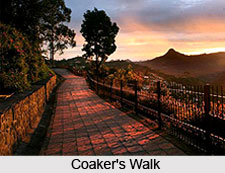 Coaker`s Walk in Dindigul : It is situated about a km from the lake. It runs along a steep slope on the southern side of the hill. This is a semi-circular beautiful path. The view from here is very captivating. The distant plain is considered as a dreamland.
Coaker`s Walk in Dindigul : It is situated about a km from the lake. It runs along a steep slope on the southern side of the hill. This is a semi-circular beautiful path. The view from here is very captivating. The distant plain is considered as a dreamland.
Kurinji Andavar Temple in Dindigul : The name of this temple is derived from a flower of this hill called `Kurinji`. This flower blooms once in 12 years in a small bush. During the flowering season, the hill look completely violet and look like a violet-tinted fairy land as the colour of this flower is violet. These flowers are very delicate.
The Kurinji Andavar temple is situated near the Prospect Point. Lord Muruga is the presiding deity of this temple. The visitors can get a glimpse of Vaigai dam from here. It is only 3.2 kms away from this place.
Telescope House in Dindigul : There are two telescopes erected in two different viewpoints in Dindigul. These are in Kodaikanal and a clear view of the plains and valleys can be seen from here. One of these telescopes is near the Kurinji Andavar temple and the other is at Coaker`s Walk. A minimum entrance fee is needed to pay visit here.
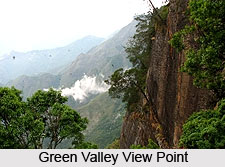 Green Valley Viewpoint in Dindigul : This view point of Dindigul is situated about 5.5 kms from the lake and near the Golf Club. A beautiful view of the entire Vaigai dam can be enjoyed from here.
Green Valley Viewpoint in Dindigul : This view point of Dindigul is situated about 5.5 kms from the lake and near the Golf Club. A beautiful view of the entire Vaigai dam can be enjoyed from here.
The Pillar Rocks in Dindigul : The Pillar Rocks are three massive granite rocks about 400 ft high. These are standing side by side on an edge by the Coaker`s Walk. It is a very charming sight. It is situated about 7.5 kms from the Kodai Lake and a nice road passing through charming greenery takes the visitors near the pillar.
Waterfalls in Dindigul : The main falls of Dindigul include the Fairy Falls, Silver Cascade, Glen Falls and Bear Shola Falls. These also serve as good picnic spots.
The Bear Shola Falls is situated about 1.5 km from the Kodai Lake. It can be reached by a picturesque ragged path. Silver Cascade is on the ghat road to Madurai 8 kms from Kodaikanal. The other falls are also within walking distance from the lake.
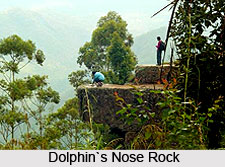 Dolphin`s Nose in Dindigul : This is situated 8 kms from the Kodai Lake and is a highland with steep gorges on either side. The deep gorges below are awesome and dizzy.
Dolphin`s Nose in Dindigul : This is situated 8 kms from the Kodai Lake and is a highland with steep gorges on either side. The deep gorges below are awesome and dizzy.
The Perumal Peak in Dindigul : This peak is considered as a trekkers` paradise. It is situated about 11 kms from Kodaikanal. The height of this peak is 2400 metres. It takes a single day to reach there on foot. It is little strenuous as the path is quite bewitching and absorbing with beautiful sceneries all through. At a point called Neutral Saddle, the actual climb of the peak begins.
Berijam Lake in Dindigul : The Berijam Lake is situated beyond Pillar Rocks at a distance of 21 kms. It is the main supplier of drinking water to Periakulam town. It is a fine picnic spot as it possess picturesque scenery.
Kukkai Cave in Dindigul : It is situated about 40 kms from Kodaikanal. This is a natural cave and the earlier cavemen used to dwell here. It is a nice camping centre with plenty scope for trekking.
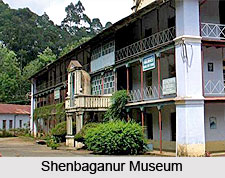 Shenbaganur Museum in Dindigul : This museum is devoted to the flora and fauna of the Dindigul hills. It is located about 5.5 kms from Kodaikanal. The Sacred Heart College, a seminary established in 1895 is running the museum here. One can also find some archaeological remains in this museum.
Shenbaganur Museum in Dindigul : This museum is devoted to the flora and fauna of the Dindigul hills. It is located about 5.5 kms from Kodaikanal. The Sacred Heart College, a seminary established in 1895 is running the museum here. One can also find some archaeological remains in this museum.
Orchidorium in Dindigul : This Orchidorium is also maintained by the Sacred Heart College. It is one of the best of its kind and contains about 300 species of orchids.



















